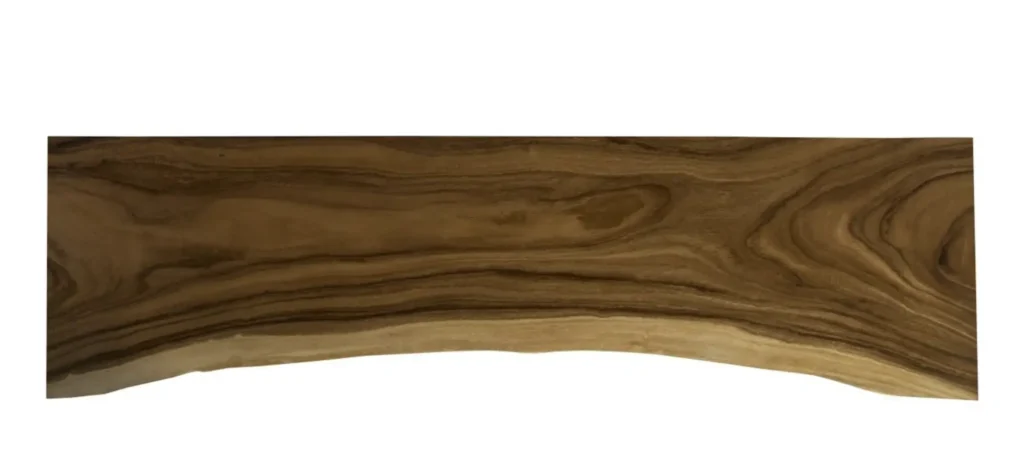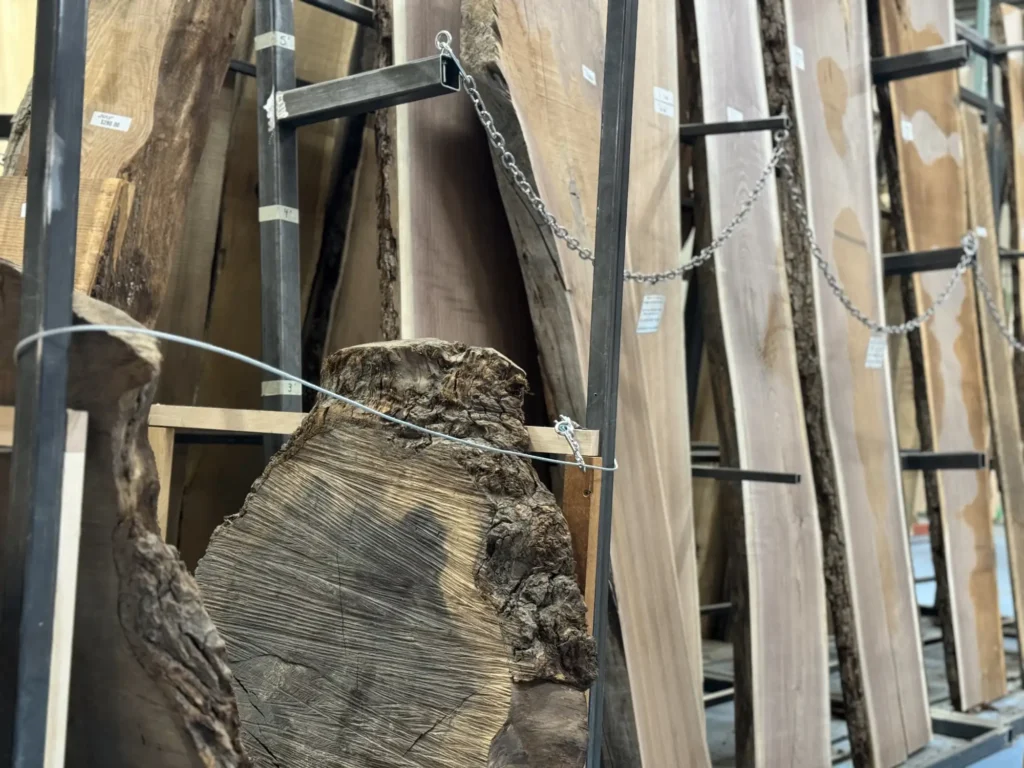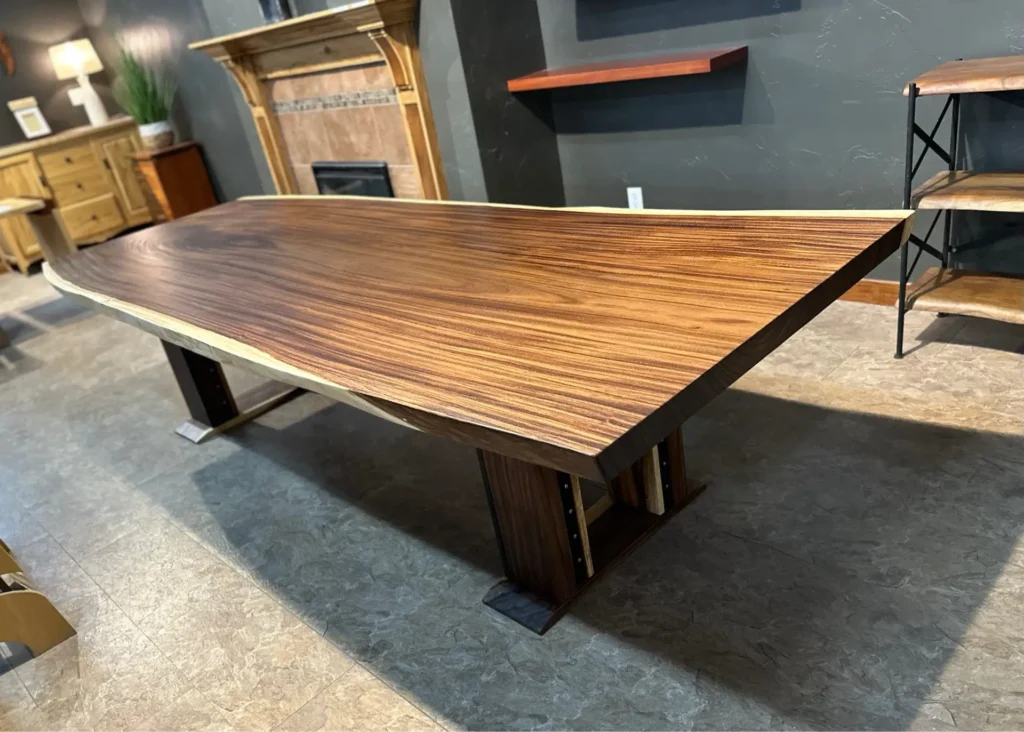Live edge lumber keeps the tree’s natural edge and shape, unlike standard lumber. It’s unique and often used in furniture for its organic, one-of-a-kind look.
Key Takeaways
- Live edge lumber retains the natural edge of the tree, resulting in unique and organic pieces of furniture that highlight the wood’s original form.
- Historically rooted in practicality, live edge lumber evolved into an artistic expression, gaining prominence through the works of designer George Nakashima in the mid-20th century.
- Challenges in working with live edge lumber include managing moisture content and the individuality of each slab, which requires careful planning and precise craftsmanship.
Understanding Live Edge Lumber

Live edge lumber is unlike any other type of wood used in furniture-making. It preserves the natural edge of the tree, including the bark and unique contours, creating a one-of-a-kind piece that showcases the tree’s original form. This natural edge, often referred to as the ‘live edge’, maintains the shape and characteristics of the tree trunk, providing an organic, raw appeal that is impossible to replicate with standard lumber.
Each slab of live edge wood features unique, organic shapes and irregular edges, making no two pieces alike. This individuality extends to the grain patterns, which add to the visual appeal and character of each piece. The presence of imperfections such as knots and voids further enhances the natural beauty and distinctiveness of live edge lumber.
When finished piece, live edge pieces are not just furniture; they are works of art. Their uniqueness ensures that each piece stands out, offering a blend of natural beauty and craftsmanship that is deeply appreciated by woodworkers in woodworking circles. The process of seasoning and finishing these live edge wood slabs enhances their natural characteristics, making them a true testament to quality and artistry in woodworking.
Origins and History of Live Edge Lumber
The origins of live edge lumber can be traced back to the 1600s, when early American settlers began using unrefined wood slabs to craft basic furniture. At that time, the focus was primarily on practicality and functionality, as settlers needed sturdy and reliable furniture to support their daily lives. Tables, chairs, and beds were created using these natural wood pieces, emphasizing the raw beauty of the materials at hand.
As time progressed, the appreciation for the natural characteristics of live edge wood grew. The shift from utilitarian use to artistic expression began to take hold, particularly in the mid-20th century. The style gained prominence in the mid-20th century, particularly through the work of George Nakashima, who embraced and celebrated the natural imperfections of wood in his furniture design. Nakashima’s work celebrated the organic imperfections of wood, incorporating them into his designs and elevating live edge lumber to a form of art.
Since the 1940s, live edge lumber has seen a substantial rise in popularity. No longer confined to rustic or traditional settings, live edge furniture is now a sought-after trend in modern interior design, appreciated for its unique beauty and connection to nature. This evolution highlights the timeless appeal of live edge wood, bridging the gap between historical craftsmanship and contemporary aesthetics.
Types of Wood Used for Live Edge Lumber

A variety of wood species are used to create live edge lumber, each bringing its own unique characteristics and aesthetic appeal. Some of the most common types include oak, walnut, maple, buckeye, willow, elm, and redwood. Each of these woods offers distinct grain patterns, colors, and textures that enhance the beauty of live edge furniture.
Walnut, particularly black walnut, is highly favored for its rich brown color and ease of workability. Claro walnut, known for its deep hues and unique figurings, is often used in high-end furniture pieces. Maple, especially hard maple or sugar maple, is renowned for its flowing grain and light color, making it a popular choice for live edge tables.
Other notable mentions include English elm, valued for its stability and suitability for larger furniture pieces, and buckeye burl, prized for its striking color variations and unique burl patterns. The selection of wood for live edge lumber often focuses on dramatic features like knots, burls, and unique figures, ensuring that each piece stands out with its own natural beauty.
The Process of Creating Live Edge Lumber
Creating live edge lumber is a meticulous process that involves several steps to preserve the natural edge of the wood and enhance its beauty. The journey begins with carefully cutting the wood slabs to remove the bark while retaining the natural contours. This initial cut is crucial, as it sets the foundation for the entire live edge piece.
Once the slabs are cut, they undergo a thorough sand process, starting with coarse grits and progressing to finer ones. This step smooths the edges while maintaining the organic shape of the wood. The purpose of sanding is to achieve a smooth surface that still retains the raw appearance of the wood, highlighting its natural beauty.
The final step involves applying finishing options such as oil, clear coat, or wax, which protect the wood and enhance its natural characteristics. These finishes not only seal the wood but also bring out the rich grain patterns and colors, resulting in a finished product that is both stunning and durable. The craftsmanship involved in each step ensures that every live edge piece is a true work of art.
Applications of Live Edge Lumber

The versatility of live edge lumber allows it to be used in a wide range of applications, from functional furniture to decorative elements. Common items crafted from live edge wood include benches, bathroom vanities, bookshelves, desks, and custom countertops. Each piece showcases the unique beauty of the natural edge, making it a focal point in any room.
Live edge lumber is not limited to residential settings; it also finds its place in commercial spaces, adding a touch of nature and elegance to offices, restaurants, and hotels. The customization options available with live edge wood enable designers to create unique shapes and finishes that cater to individual tastes and preferences.
Whether used for furniture, countertops, shelves, or decor items, live edge lumber brings a rustic yet sophisticated charm to any space. Its ability to connect occupants with the natural world makes it a popular choice for those looking to add a touch of organic beauty to their living spaces.
Benefits of Live Edge Lumber
One of the main attractions of live edge lumber is its organic and warm appearance, which brings a sense of nature and tranquility into any space, reminiscent of a forest. The natural contours of the tree are preserved, offering unique character and charm to each piece of timber. This individuality is a significant draw for consumers seeking distinctive furniture that stands out from mass-produced items.
In addition to its aesthetic appeal, live edge lumber is also valued for its sustainability. Live edge furniture repurposes entire wood slabs, turning logs that might otherwise be discarded into beautiful pieces, thereby reducing waste and promoting eco-friendly practices.
The versatility of live edge wood further enhances its appeal, making it suitable for various styles and applications.
Challenges in Working with Live Edge Lumber
Working with live edge lumber presents several challenges that require careful consideration and skill. One of the primary issues is managing the moisture content of the wood, which can impact its stability and lead to warping or cracking if not properly controlled. Seasoning the wood before use is essential to ensure its stability and prevent future issues.
Another challenge is the variability in the quality and condition of the wood. Wood sourced from older structures may have issues like insect damage or mold that must be addressed before use. Additionally, DIY cuts can be less precise and have more defects compared to professionally cut slabs, complicating projects and increasing labor and material costs.
Designing with live edge wood also necessitates special considerations for project planning. The unique characteristics of each live edge wood slab, including knots, burls, and natural contours, require careful planning and execution to ensure the final product meets both functional and aesthetic requirements. Taming the wood’s natural tendencies and moisture behavior is a critical skill in this process, especially when working with a live edge slab.
Maintenance and Care for Live Edge Pieces
Proper maintenance and care are crucial to preserving the beauty and longevity of live edge pieces. Keeping live edge furniture out of direct sunlight and maintaining stable humidity levels are vital to preventing warping and cracking. Fluctuations in temperature and humidity can cause significant damage, so it’s essential to control the environment where the furniture is placed.
Regular cleaning and protection are also important. Using table pads and coasters can safeguard the surface from scratches and heat exposure. Spills should be absorbed immediately with a soft cloth to prevent staining. Routine dusting with a microfiber cloth helps keep the surfaces looking their best.
For long-term care, live edge furniture should be refinished every few years to maintain its beauty and durability. Oil-based finishes enhance the wood’s appearance but require more frequent reapplication. Properly caring for live edge pieces can increase their value over time and ensure they remain stunning focal points in your home.
Cost Factors of Live Edge Lumber
The cost of live edge lumber is influenced by several factors, including:
- The labor-intensive process of crafting each piece
- Skilled cutting
- Meticulous sanding
- Expert finishing techniques
All these contribute to the higher price of live edge furniture compared to traditional lumber. The unique characteristics of each slab, such as size, thickness, species, and shape, also play a role in determining the final cost.
Despite being more expensive, live edge lumber offers a sustainable alternative to standard lumber. By utilizing entire slabs, it reduces waste and makes use of logs that might otherwise be discarded, promoting eco-friendly practices. This combination of artistry, sustainability, and uniqueness justifies the investment in live edge furniture for many consumers.
Popularity and Trends in Live Edge Design
Live edge furniture has seen a significant rise in popularity in recent years, finding its place in both home and commercial environments. The trend has evolved from rustic styles to incorporating modern elements like sleek lines and metal accents, making it versatile and suitable for various design aesthetics. Whether in a chic urban loft or a cozy countryside home, live edge pieces add a touch of natural beauty and warmth to any space, showcasing the charm of live edges.
One of the reasons for this popularity is the individuality of each piece. No two live edge tables are alike, as each retains the unique contours and grain variations of the original tree and ash, with at least one side showcasing its natural beauty. This uniqueness appeals to those looking for decor that stands out and reflects their personal style. A live edge table exemplifies this individuality a bit perfectly.
The integration of live edge furniture into diverse design styles highlights its log adaptability and timeless life appeal.
Summary
In summary, live edge lumber offers a unique blend of natural beauty, craftsmanship, and sustainability. From its historical roots with early American settlers to its modern-day applications in stylish interiors, live edge furniture continues to captivate and inspire. The various types of wood used, the intricate process of crafting each piece, and the numerous applications highlight its versatility and appeal.
As we embrace this trend, the importance of proper care and maintenance cannot be overstated. By preserving the natural edge and celebrating the imperfections of each slab, we honor the tree’s journey and bring a piece of nature into our homes. Live edge lumber is more than just a design choice; it’s a testament to the beauty and resilience of the natural world.
Frequently Asked Questions
What is live edge lumber?
Live edge lumber is wood that maintains the tree’s natural edge, including bark and unique contours, resulting in a distinctive piece that highlights the original form of the tree.
What are the benefits of using live edge lumber?
Using live edge lumber adds unique character and warmth to your space while promoting sustainability through the repurposing of logs. Its organic aesthetics and natural imperfections make each piece distinct and appealing.
What types of wood are commonly used for live edge lumber?
Live edge lumber typically utilizes oak, walnut, maple, buckeye, willow, elm, and redwood, each bringing unique beauty and characteristics to the final product. Consider these species for their aesthetic appeal in your projects.
How do you maintain live edge furniture?
To maintain live edge furniture effectively, ensure stable humidity and protect it from direct sunlight. Using table pads and coasters, cleaning spills immediately, and refinishing every few years will help preserve its beauty and durability.
Why is live edge lumber more expensive than traditional lumber?
Live edge lumber is more expensive than traditional lumber due to the labor-intensive craftsmanship required for each piece, which includes skilled cutting and finishing, as well as its unique characteristics. This attention to detail and individuality justifies the higher price.

